Spoiler Alert
My fellow Bitch Flicks writer Rachel Redfern recently posted a review of The Hobbit: The Desolation of Smaug that was insightful, and I agree with most of her points. She touches on the discomfort surrounding creating a whole new major character for the film in the form of Tauriel played by the athletic Evangeline Lilly. As a purist, I was certainly uncomfortable with the idea. I got over it. I had to admit that without Tauriel, a brilliantly capable captain of the guard for the Mirkwood elves, the film would be a dwarvish sausagefest. Redfern also highlights the ick-factor in the love triangle in which Tauriel gets enmeshed. The important thing that I’d like to add to our Bitch Flicks conversation about The Desolation of Smaug is that the representation of Tauriel brings into sharp focus the primary purpose of women within the world of Middle Earth: to be love objects for male characters.
For some context, let’s take a look at the only other two women who have a character arc in all of Middle Earth. First, there’s Éowyn, shieldmaiden of Rohan.

Éowyn had the biggest role of any of the women in J.R.R. Tolkien‘s beloved fantasy novel series The Lord of the Rings. The books themselves as well as the films actually chronicle her regret at not having the freedom to fight to defend her people and win honor and glory in battle as men are allowed to do. Éowyn (in both the books and films) single-handedly takes down one of the Nine, a Nazgûl, a Ringwraith. She faces off against the debilitating terror it exudes, and she wins. That is so hardcorely badass. She was hands-down my favorite character in the books.
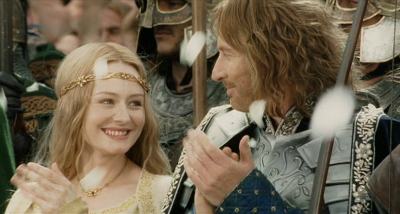
The twist is that Aragorn then has to save her life from the poison of the Ringwraith, and Faramir, the second son of the Steward of Gondor (and Boromir’s little brother), saves her life again by showing her how to love…i.e. how to be a woman. The fire goes out of Éowyn when she settles down and learns her place as the consort of Faramir. All her dreams of being considered an equal to men, of standing side-by-side men on a battlefield and commanding respect goes out the window because, apparently, all women really want and are good for is love and marriage.
Then we have Arwen, the daughter of Elrond and elvish princess of Rivendell. Director Peter Jackson takes a lot of liberties with this character in the film version of The Lord of the Rings. He generally made Arwen more visible (I think she’s only in two scenes in the books) and more active in that she saves Frodo from death at the hands of the Nine, which seemed cool at first, but with the introduction of the similar character of Tauriel in The Desolation of Smaug, this whole healing trope gave me pause. In The Fellowship of the Ring, Arwen uses herbs and elvish magic to heal Frodo from the poisonous wound he took from a Morgul-blade, offering up her immortality in prayer for his life.
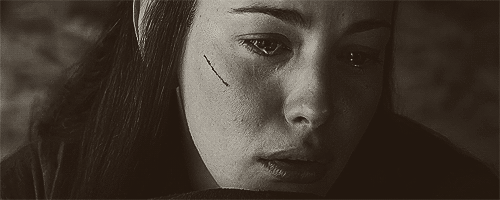
Tauriel abandons her quest to destroy the orc infestation at their source, and she also abandons Legolas, her friend of 600 years, to perform a similar healing rite on a dwarf she’s known for a couple of days. What could be more important than friendship? More important than the personal quest that she defied her sovereign to follow? Hmm…
Jackson also plays up the tragic love story between Arwen and Aragorn to a nauseating level, making her life tied to the fate of the quest to destroy the ring. This renders her helpless and in need of saving after he’d already built her up as an elvish warrior with mad healing abilities. Arwen is divested of her prowess as well as her immortality for love. In the end, she’s simply a prize for Aragorn to claim at the end of his journey because her story is completely suspended until the dudes can rescue her…Sleeping Beauty style.

This brings us to Tauriel. I’m glad she was included in the storyline of The Desolation of Smaug. She’s an elegant, fierce, and brilliant warrior.
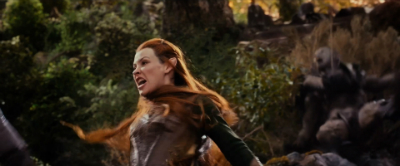
She’s strong, defiant, and makes her own choices.
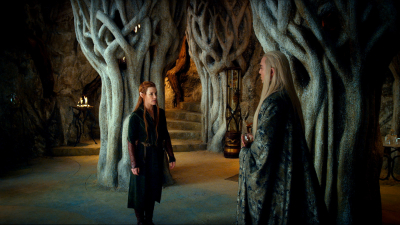
I’m glad that Peter Jackson recognized that having a movie with no women in it is absolutely absurd.
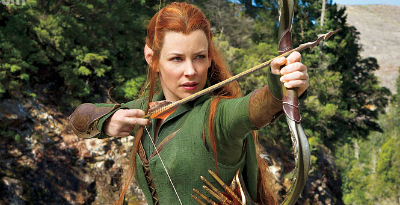
BUT. There it is, the big but. But Jackson, like so many other male storytellers, can’t imagine a path for Tauriel that doesn’t include love. Tauriel is the love object of two male characters creating a noxious love triangle, and she, like Arwen and Éowyn, must sacrifice everything for that love.
I thought a lot about why Jackson created Tauriel. He’s already messing with the events, chronology, and mythology of the books, so why didn’t he just change the gender of a handful of major characters to make them into women? Why couldn’t we have a female dwarf or two? Why couldn’t the last remaining “skin-changer” the bear-man Beorn have been a woman? Or the Brown Wizard Radagast have been a lady forest foraging force of nature? Answer: Because none of those characters have the potential to be love interests. Instead, Jackson created a throw-away character that he could shape into a love object. I am so tired of seeing women have to give up their identity, their goals, their independence, and their power for love. And why is female love synonymous with sacrifice?
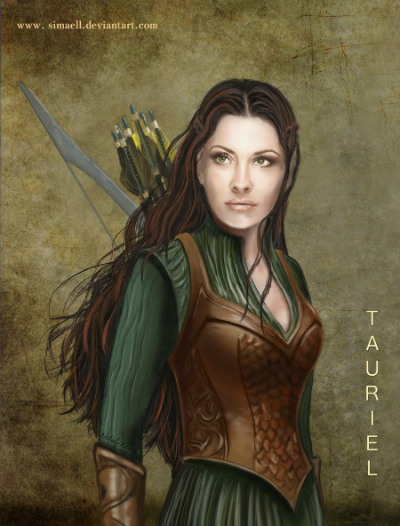
I can’t say how Jackson will tie it all up in his conclusion to the ridiculously drawn out trilogy of The Hobbit. Who knows? Maybe he’ll end the series with Tauriel having been instrumental, self-actualized, and above the pressures of our pitiful contemporary love culture that insists all a woman needs is love to be whole. Based on his current trajectory and track record, though, it’s not looking so hot. Sigh. It doesn’t look like a good day to be a woman on Middle Earth.
——————
Amanda Rodriguez is an environmental activist living in Asheville, North Carolina. She holds a BA from Antioch College in Yellow Springs, Ohio and an MFA in fiction writing from Queens University in Charlotte, NC. She writes all about food and drinking games on her blog Booze and Baking. Fun fact: while living in Kyoto, Japan, her house was attacked by monkeys.
